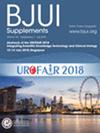Ureteroenteric strictures following retrosigmoid vs. conventional ileal conduit – The MOSAIC study (The DaBlaCa‐16 study)
IF 4.4
2区 医学
Q1 UROLOGY & NEPHROLOGY
引用次数: 0
Abstract
ObjectivesTo evaluate the rate of left‐sided ureteroenteric strictures (UES) following robot‐assisted radical cystectomy (RARC) with a retrosigmoid ileal conduit compared to a conventional ileal conduit in a randomised controlled trial (RCT).Patients and MethodsThis multicentre, RCT included 303 patients undergoing RARC between May 2020 and August 2022. Patients were randomised to receive either a retrosigmoid or a conventional ileal conduit. Analyses were performed an intention‐to‐treat basis.ResultsOf the 149 patients randomised for the retrosigmoid ileal conduit, a total of 137 (92%) patients received the allocated conduit. In the control group, 150 of 154 (97.4%) patients underwent RARC and one patient was lost to follow‐up. At a median follow‐up of 754 days, the rate of left‐sided UES was 4.1% (six of 148) in the intervention group and 6.7% (10 of 149) in the control group (乙状结肠后输尿管狭窄vs.传统回肠导管- MOSAIC研究(DaBlaCa‐16研究)
目的在一项随机对照试验(RCT)中评估机器人辅助根治性膀胱切除术(RARC)后乙状结肠后回肠导管与传统回肠导管相比,左侧输尿管肠狭窄(UES)的发生率。患者和方法该多中心RCT纳入了303例在2020年5月至2022年8月期间接受RARC治疗的患者。患者随机接受乙状结肠后导管或常规回肠导管。分析是在意向治疗基础上进行的。结果在149例随机选择乙状结肠后回肠导管的患者中,共有137例(92%)患者接受了分配的导管。在对照组中,154例患者中有150例(97.4%)接受了RARC治疗,1例患者没有随访。在中位754天的随访中,干预组左侧UES发生率为4.1%(6 / 148),对照组为6.7% (10 / 149)(P = 0.31)。术后肌酐清除率和代谢并发症(包括维生素B12缺乏和代谢性酸中毒)无显著差异。结论乙状窦后导管与常规入路相比,左侧UES发生率无明显降低。然而,该手术是可行的,不会增加代谢并发症的风险,因此在需要广泛切除左输尿管时可能是一个很好的选择。
本文章由计算机程序翻译,如有差异,请以英文原文为准。
求助全文
约1分钟内获得全文
求助全文
来源期刊

BJU International
医学-泌尿学与肾脏学
CiteScore
9.10
自引率
4.40%
发文量
262
审稿时长
1 months
期刊介绍:
BJUI is one of the most highly respected medical journals in the world, with a truly international range of published papers and appeal. Every issue gives invaluable practical information in the form of original articles, reviews, comments, surgical education articles, and translational science articles in the field of urology. BJUI employs topical sections, and is in full colour, making it easier to browse or search for something specific.
 求助内容:
求助内容: 应助结果提醒方式:
应助结果提醒方式:


